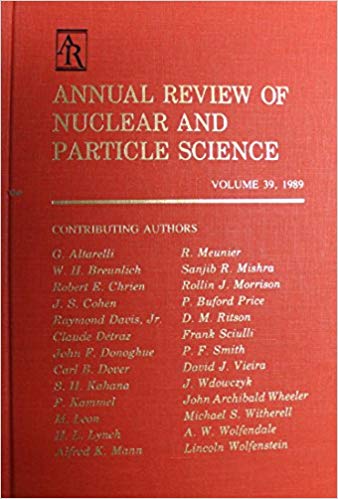杰弗逊实验室12gev:科学项目
IF 9.1
2区 物理与天体物理
Q1 PHYSICS, NUCLEAR
Annual Review of Nuclear and Particle Science
Pub Date : 2018-10-19
DOI:10.1146/ANNUREV-NUCL-101917-021129
引用次数: 31
摘要
杰斐逊实验室对其连续电子束加速器设施(CEBAF)的升级最近已经完成。该项目包括对加速器进行升级,以达到12 GeV的最大光束能量,并建造第四个终端站,实验大厅D,以及为现有三个大厅(a, B和C)中的两个新建探测器设备。已经制定了一个广泛的实验计划,通过测量深度排他和半包容过程来绘制核子在横向空间和纵向动量中的固有夸克分布。并通过研究波函数中具有活跃胶子自由度的强子的光谱来探索色约束。其他项目包括大夸克动量分数x处的正向部分子分布函数,夸克和胶子极化分布函数,测量核子基态的电磁形状因子和短距离的核子共振跃迁,以及探索超越标准模型的高精度奇偶违反过程和寻找暗物质信号的物理。这篇综述强调了强子和核科学的主要领域,这将是前5年运行的重点。本文章由计算机程序翻译,如有差异,请以英文原文为准。
Jefferson Lab at 12 GeV: The Science Program
Jefferson Lab's upgrade of its Continuous Electron Beam Accelerator Facility (CEBAF) has recently been completed. The project involved an upgrade of the accelerator to achieve a maximum beam energy of 12 GeV and the construction of a fourth end station, Experimental Hall D, as well as new detector equipment for two of the three existing halls (A, B, and C). A broad experimental program has been developed to map the nucleon's intrinsic quark distributions in transverse space and in longitudinal momentum through measurements of deeply exclusive and semi-inclusive processes, and to probe color confinement by studying the spectrum of hadrons with active gluon degrees of freedom in the wave function. Other programs include the forward parton distribution function at large quark momentum fraction x, the quark and gluon polarized distribution functions, measurements of electromagnetic form factors of the nucleon ground state and of nucleon resonance transitions at short distances, and the exploration of physics beyond the Standard Model in high-precision parity-violating processes and in the search for signals of dark matter. The higher beam energy is also suitable for exploration of quark hadronization properties using the nucleus as a laboratory. This review highlights major areas of hadron and nuclear science that will be the focus of the first 5 years of operation.
求助全文
通过发布文献求助,成功后即可免费获取论文全文。
去求助
来源期刊
CiteScore
21.50
自引率
0.80%
发文量
18
期刊介绍:
The Annual Review of Nuclear and Particle Science is a publication that has been available since 1952. It focuses on various aspects of nuclear and particle science, including both theoretical and experimental developments. The journal covers topics such as nuclear structure, heavy ion interactions, oscillations observed in solar and atmospheric neutrinos, the physics of heavy quarks, the impact of particle and nuclear physics on astroparticle physics, and recent advancements in accelerator design and instrumentation.
One significant recent change in the journal is the conversion of its current volume from gated to open access. This conversion was made possible through Annual Reviews' Subscribe to Open program. As a result, all articles published in the current volume are now freely available to the public under a CC BY license. This change allows for greater accessibility and dissemination of research in the field of nuclear and particle science.

 求助内容:
求助内容: 应助结果提醒方式:
应助结果提醒方式:


